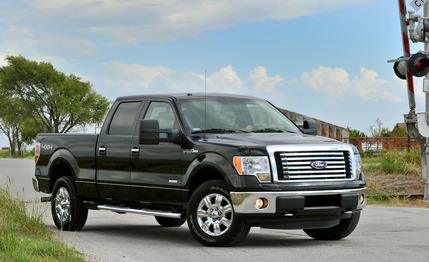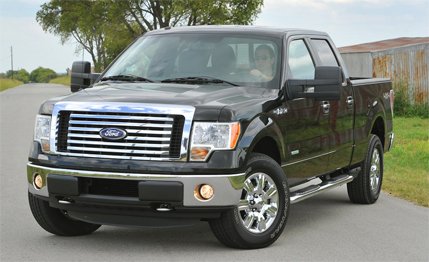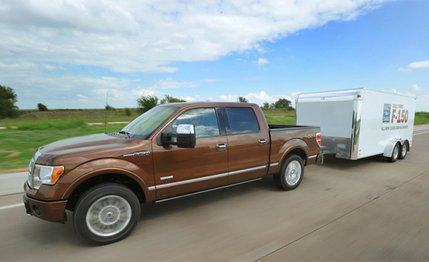
 First Drive Review
First Drive Review
Major updates to the F-150, already the bestseller in one of the largest market segments, represent a serious gamble for Ford. Pickup-truck buyers, after all, notoriously favor the tried-and-true. With high-tech features like twin turbochargers and direct injection, the 2011 F-150’s EcoBoost V-6 might as well be a hood-mounted tofu dispenser.
Changing the Game
But if there’s one thing truck loyalists like more than the familiar, it’s horsepower and torque, and the EcoBoost whips up a satisfactory 365 hp and 420 lb-ft on regular unleaded. It’s one of four new F-150 powerplants for 2011: a 302-hp, 3.7-liter V-6 is standard; the anemic 310-hp, 5.4-liter V-8 gets chucked for gutsy 5.0- and 6.2-liter V-8s producing 360 and 411 hp. (Click here to see how the new engine lineup compares with those from Chevy and Dodge.) The 6.2-liter “Boss” V-8 is reserved for special high-end F-150s—such as the SVT Raptor—making the EcoBoost V-6 the top-of-the-line engine for volume F-150 buyers.
That means those who want the strongest available mill in a regular Ford truck will have to forsake the V-8 rumble that has defined cab-and-a-box workhorses for decades. Ford understands that traditionalists will take some convincing, and it doesn’t help matters that the EcoBoost will command $1750 more than the 3.7-liter V-6 and $750 more than the 5.0-liter V-8. Regardless of output figures, V-6s don’t make the same chicken-fried music as V-8s.


Deceptively Powerful
Although its fitment in the F-150 is the twin-turbo V-6’s first rear-drive application—it’s also the first turbocharged V-6 in a full-size pickup—it is offered in several other Ford and Lincoln models, where it makes up to 365 hp and 350 lb-ft. Those output figures propel the 4300-pound Taurus SHO to 60 mph in 5.2 seconds. For the F-series, the engine is revised with new turbos and intercoolers, as well as new intake and exhaust manifolds, various revised internals, and new electronic controls for the dual variable valve timing. The EcoBoost, as with all other F-150 engines, is mated solely to Ford’s updated 6R80 six-speed automatic transmission with manumatic shifting; the blown engine is available in nearly every body configuration with either rear- or four-wheel drive.
If you overlook its rather flat exhaust note, it would be easy to mistake the EcoBoost V-6 for a burly V-8. We drove several F-150 models—as well as competitive trucks—both unladen and towing trailers weighing up to 6700 pounds, and the EcoBoost felt noticeably strong and never seemed to run out of breath. Ford says 90 percent of the engine’s torque is on tap from 1700 rpm to 5000. We observed that the new turbos spool up quickly and emit only a slight whistle under load.
Acceleration is almost diesel-like in its relentlessness, and the truck has more than enough in reserve for passing maneuvers, even with a trailer behind. Capable of tugging 11,300 pounds or carrying 3060 in the bed—both best in the segment—the F-150 EcoBoost managed Ford’s trailers with ease, chugging along smoothly in top gear on uphill highway sections.
Little Else New
All F-150s except those with the 6.2-liter V-8 get electrically assisted power steering for 2011, which is another first for a full-size truck. The setup is more efficient than a hydraulic setup and makes for easy low-speed maneuvering, but it offers nil in the way of feel. With little else new for 2011, the F-150 otherwise drives as it did before, which is to say solid and refined but not quite as handily as the Ram 1500, which won our last pickup-truck comparison test in 2009.
The 2011 truck’s interior is much the same as the 2010’s; the biggest update is the addition of an available 4.2-inch information screen in the revised gauge cluster. First seen on the 2011 F-series Super Duty, the new readout features multiple displays for the trip computer and various functions, such as fuel economy, vehicle settings, and trailer-towing details. An off-road setting tracks the truck’s vertical and lateral movements. Like learning a new smartphone, it’s rather overwhelming at first but intuitive and informative once you master the system.


In general, MSRPs increase by about two grand from 2010’s, although exact figures get confusing given the numerous configurations of the six trims available with the EcoBoost. The least expensive EcoBoost variant is a $25,440 regular-cab XL with rear-wheel drive and an eight-foot bed; the priciest is a four-wheel-drive Platinum SuperCrew with a 6.5-foot bed, which starts at $48,770. As with all pickups, options can swell the bottom line considerably.
Although the turbocharged V-6 has the potential to deliver better mileage than a V-8, we’ve noticed in other EcoBoost Fords that their much-touted efficiency increase pretty much disappears when driving with any sort of haste. But that’s less important here than in other segments, since, in truth, most pickup owners accept crappy fuel economy as a part of the deal. Given that, and having now experienced the power and performance of the EcoBoost F-150, we think most potential customers will feel right at home in the driver’s seat.